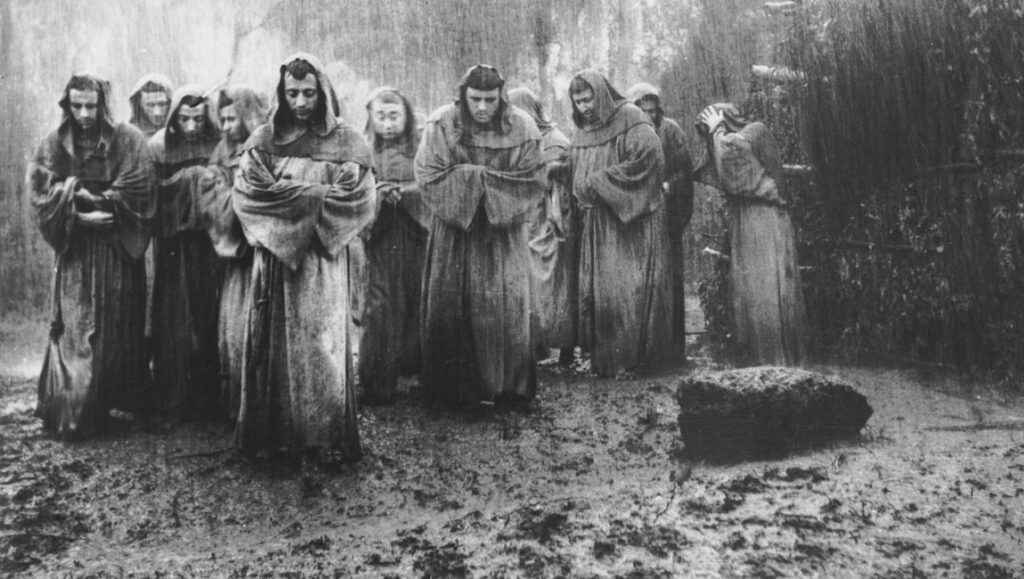Although The Flowers of St. Francis sits comfortably within one Roberto Rossellini’s most lauded creative stretches , it’s a work that still doesn’t exactly have a home in any of the three subcategories that have been parceled out from the director’s filmography: the neorealist period, his partnership with Ingrid Bergman, and a patient career denouement in the form of the historical films. The Flowers of St. Francis is traceable in all these mentioned, and yet also bucks whatever template we can reductively draw from them. The film interlocks its loose vignettes with the recurring cast, as opposed to Rome, Open City’s (1945) neat bifurcation, or Paisan’s (1946) upward path through war-torn Italy; the historical films would encompass similar subject matter, but they often occurred along a preordained timeline that eschewed episodic structuring (The Flowers of St. Francis also came long before Rossellini was cutting in the camera and producing fluid and immersive scenery with the aid of the Pan Cinor zoom lens). Thus, this 1951 film is constituted from a comparatively conventional cinematic grammar, and is more resolutely theological than anything else this Italian director had ever produced, his intertwined platonic spirituality and agnosticism engendering a relaxed and inviting religious outlook, bolstered by the inclusion of the monks of the Nocera Inferiore Monastery.
Rossellini doesn’t feign holistic biography, nor does he tout Saint Francis (Brother Nazario Gerardi) as an authoritative figure, instead often decentering the saint within his obsequious and touchingly naïve flock. Freed from biopic strictures, The Flowers of St. Francis exists as a free-flowing study of influence and faith, and how the two complement each other. Like Francis, however, Rossellini also prefers to disappear into the finished product, his resounding message of a lifestyle of simplicity — as a balm for postwar Europe — is achieved modestly, even if the director was plunging into matters of religious historicity, and claimed to have taken the medieval paintings of the time period documented as inspiration.
In an over-quoted statement of expected grandiloquence (to otherwise appropriately crown the cinema of Nicholas Ray), Jean Luc-Godard posited that Rosselini’s inarguable artform forebear was painting; even if such a description now comes attached at the hip when discussing the work of the director, the confirmed, painterly aspirations invite such linkage. Rossellini’s penchant for location shooting is just as present in The Flowers of St. Francis as it is in the War Trilogy or the films with Bergman, and the way that nature frequently creeps in from and adorns the edges of the frame suggests an affinity with the American King Vidor, whose own transcendentalism is applicable here. The humble makeup of each chapter is also beholden to painting, where every visible image is catalyzed by a single event, such as lending a tunic, walking with a leper, or hosting Sister Clare and her convent. Within whatever could qualify as “realism” or “accuracy” is one or two hyperstylized elements, such as the aforementioned day-for-night lit promenade, or Brother Ginepro’s (Brother Severino Pisacane) honorable visit to the war-camp of Nicolai the Tyrant (Aldo Fabrizi).
The Italian title, Francesco, giullare di Dio, translates to “Francis, God’s Jester,” although the character who enacts the most ostensibly foolish behavior is Ginepro (of course, the intricacies of the subtitle manifests itself in the moments where Francis’s benevolence fails or is ill-conceived). Ginepro — following episodes that result in his nudity and his pilfering of a farmer’s pig — finds himself in the company of Nicolai and his horde, the sole interval of the film that ditches picturesque naturalism for an artifice of evil, as evidenced by the disproportionately large weapons wielded (clearly made of cardboard), and Fabrizi himself, hoisted into a giant suit of armor and sporting the most generically “menacing” mustache and mane. Saccharine selfishness is tempered by cartoonish malevolence, and vice versa, resulting in one of the film’s most terrifying images: a beaten and bloodied Ginepro dazedly wandering away from a torched camp. When the monks disband in the end, in a poignant display of schoolboy-esque dizziness — they decide their respective diverging paths by spinning with their eyes closed — the Nicolai chapter is lodged in the memory as much as Francis asking the birds for momentary quiet to pray.
Part of Kicking the Canon – The Film Canon.


Comments are closed.